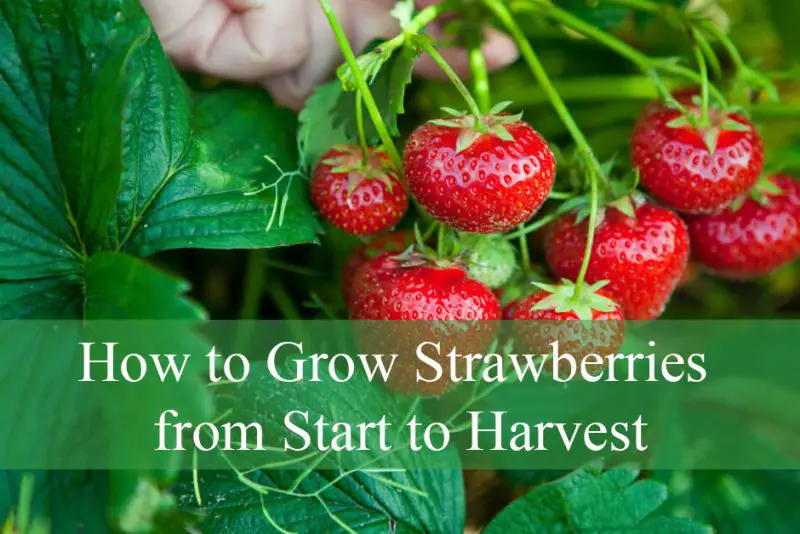Growing strawberries is a rewarding gardening endeavor that brings the joy of fresh, sweet fruit straight from your own garden. If you have ever wondered how to grow strawberries successfully, this guide is designed to help you achieve just that. Strawberries are not only delicious but also relatively easy to cultivate, making them a favorite choice for gardeners of all skill levels. By understanding the basics—from selecting the best varieties to preparing your soil properly—you can set the foundation for a healthy and productive strawberry patch.
In this detailed guide on how to grow strawberries, you will learn every essential step needed to nurture your plants throughout the growing season. From planting techniques and ongoing care to harvesting tips, this resource covers it all, ensuring that you can enjoy juicy, flavorful strawberries year after year. Whether you have a large garden or limited space, this comprehensive approach will help you maximize your strawberry yield and bring the sweetness of homegrown fruit to your table.
Why Grow Strawberries?

Strawberries are among the most popular and versatile fruits enjoyed around the world. Growing strawberries in your garden offers many valuable benefits that make it a great choice for gardeners of all levels. The following reasons highlight why adding strawberries to your garden is a rewarding decision.
Delicious and Nutritious
First and foremost, strawberries are not only delicious but also highly nutritious. They are packed with essential vitamins such as vitamin C, antioxidants, and dietary fiber. These nutrients play an important role in supporting overall health and boosting the immune system. Picking and eating fresh strawberries straight from your own garden provides a delightful taste experience while adding valuable nutrients to your diet.
Easy to Grow
In addition, strawberries are easy to grow and care for. They adapt well to a variety of soil types and climates as long as they receive adequate sunlight and moisture. Whether you are a beginner or an experienced gardener, growing strawberries is relatively simple and rewarding. With proper care, you can expect to harvest a bountiful crop. This ease of cultivation makes strawberries an ideal fruit choice for those looking for low-maintenance gardening options.
Suitable for Small Spaces
Another great advantage of strawberries is their suitability for small spaces. You don’t need a large garden plot to grow them successfully. Strawberries thrive in containers, raised beds, or traditional garden beds. This makes them perfect for balconies, patios, or other limited garden areas. Thanks to this flexibility, almost anyone can enjoy homegrown strawberries regardless of space constraints.
Extended Harvest Season
Finally, depending on the variety you choose, strawberries can offer an extended harvest season. Some types produce fruit from late spring through fall, allowing you to enjoy fresh, sweet berries over several months. This prolonged picking period adds even more value to growing strawberries, ensuring a steady supply of fresh fruit throughout the growing season.
Choosing the Right Strawberry Varieties
Selecting the right strawberry variety is essential to ensure a successful and satisfying harvest. Strawberries are generally classified into three main types, each with its own unique growing habits and harvest patterns. Understanding these differences will help you pick the perfect variety for your garden.
June-Bearing Strawberries
June-bearing strawberries produce one large crop per year, usually ripening in late spring or early summer. This type is ideal for gardeners who prefer a big, concentrated harvest all at once. Popular June-bearing varieties include ‘Chandler,’ ‘Earliglow,’ and ‘Allstar,’ known for their sweet flavor and high yields.
Ever-Bearing Strawberries
Ever-bearing strawberries yield two to three smaller crops spread throughout the growing season, typically in spring, summer, and fall. They are great for gardeners who want to enjoy fresh strawberries multiple times during the year rather than in a single harvest. Varieties like ‘Ozark Beauty’ and ‘Quinault’ are popular ever-bearing choices due to their steady fruit production.
Day-Neutral Strawberries
Day-neutral strawberries produce fruit continuously throughout the growing season, regardless of day length. This makes them perfect for mild climates or for gardeners who want strawberries throughout the season. Common day-neutral varieties include ‘Seascape’ and ‘Albion,’ both praised for their consistent yields and excellent flavor.
Preparing Your Garden for Strawberries
Successful strawberry growing starts with careful and thorough preparation of your garden. Ensuring the right soil conditions, site selection, and soil preparation are key factors that influence the health and productivity of your strawberry plants.
Soil Requirements
Strawberries thrive best in well-drained, sandy loam soil that maintains a slightly acidic to neutral pH level, ideally between 5.5 and 6.8. This type of soil allows for good root development and proper moisture balance. It is important to avoid heavy clay soils or low-lying areas where water tends to pool, as strawberries do not tolerate soggy or waterlogged roots. Excess moisture can lead to root rot and other diseases that harm the plants.
Site Selection
Choosing the right site for planting strawberries is equally important. The location should receive full sun, providing at least six to eight hours of direct sunlight each day. Adequate sunlight is crucial for the plants to produce sweet, flavorful fruit and to encourage healthy growth. Additionally, good air circulation around the planting area helps reduce the risk of fungal diseases by keeping the foliage dry. It is also advisable to avoid planting strawberries in areas where tomatoes, peppers, eggplants, or potatoes have been recently grown. These crops share similar soil-borne diseases with strawberries, and rotating planting sites helps minimize the chances of infection.
Soil Preparation
Before planting, testing the soil pH is recommended to ensure it falls within the optimal range. If necessary, amendments can be applied to adjust the pH—lime is used to raise pH levels, while sulfur can lower them. Improving soil fertility and structure is equally important; this can be achieved by working in organic matter such as compost or well-aged manure. These materials enrich the soil with nutrients and improve drainage and texture. Finally, it is essential to clear the planting area of all weeds and debris to reduce competition for nutrients and water, creating a clean environment for your strawberry plants to flourish.
Planting Strawberries: Step-by-Step Guide
Planting strawberries correctly is essential to establish healthy plants that will produce abundant fruit. Following the right timing and proper planting techniques will set you up for success.
When to Plant Strawberries
In most regions, the ideal time to plant strawberries is in early spring, just after the danger of the last frost has passed. This timing allows the plants to establish themselves during the cooler, wetter part of the year before the warmer growing season begins. However, in warmer climates where winters are mild, planting strawberries in the fall is also possible and often preferred. Fall planting gives the plants a chance to develop strong roots before the heat of summer arrives.
How to Plant Strawberries
Before planting, if you are using bare-root strawberry plants, it is important to prepare them by soaking their roots in water for about 30 minutes. This step helps rehydrate the roots and improves their chances of successful establishment. When planting, dig individual holes spaced approximately 12 to 18 inches apart, with rows separated by 3 to 4 feet to provide enough room for growth and airflow. The depth of planting is crucial: place the crown of each strawberry plant—where the roots meet the stems—just slightly above the soil surface. This prevents the crown from being buried too deeply, which can cause rot, or left too exposed, which can dry it out. After positioning the plant, gently fill the hole with soil, firming it lightly to eliminate any air pockets around the roots. Once planted, water the strawberries thoroughly to settle the soil and provide moisture essential for root development.
Planting in Containers or Raised Beds
Strawberries are very adaptable and can also be grown successfully in containers or raised beds. When planting in containers, choose a high-quality potting mix that is rich in organic matter to provide nutrients and retain moisture. Raised beds should be filled with well-prepared soil that drains well and contains plenty of organic material. It is important to ensure containers have sufficient drainage holes to prevent waterlogging, which can damage strawberry roots. When planting in these settings, space the plants appropriately to allow good airflow between them, which helps reduce disease risk and promotes healthy growth.
Strawberry Plant Care and Maintenance
Proper care and maintenance are vital to keep strawberry plants healthy and productive. Regular attention to watering, mulching, fertilizing, pruning, and seasonal care can significantly improve your harvest.
Watering
Strawberries require consistent moisture, ideally about one to two inches of water per week. It is best to water early in the day so that the leaves have time to dry before nightfall, which helps reduce the risk of fungal diseases. Using drip irrigation or soaker hoses is recommended as these methods deliver water directly to the soil and roots while keeping the foliage dry. This approach helps prevent common diseases caused by wet leaves.
Mulching
Applying mulch around your strawberry plants offers several benefits. Materials such as straw, pine needles, or black plastic mulch help conserve soil moisture by reducing evaporation. Mulch also suppresses weeds, reducing competition for nutrients and water. Additionally, it keeps the fruit clean by preventing direct contact with soil. In colder climates, mulch acts as insulation, protecting the roots from freezing temperatures during winter. Proper mulching contributes to healthier plants and better yields.
Fertilizing
Before planting strawberries, it is beneficial to mix a balanced fertilizer into the soil to provide essential nutrients. After the plants are established, side-dressing with a nitrogen-rich fertilizer once in early spring and again after the harvest encourages vigorous growth and fruit production. However, caution is necessary to avoid over-fertilizing, as this can lead to excessive leafy growth at the expense of berry development, resulting in fewer and smaller fruits.
Pruning and Runner Management
During the first four to six weeks after planting, it is advisable to remove flower buds. This practice encourages the plants to focus their energy on developing strong roots and leaves, which supports better fruiting later on. Strawberry plants produce runners—long stems that generate new daughter plants. If your goal is to harvest larger berries, it is best to remove these runners to direct energy toward fruit production. Conversely, if you want to propagate new plants, allow the runners to grow and root. Regularly trimming dead or diseased leaves also helps maintain plant health and reduces disease spread.
Winter Care
In regions with cold winters, protecting strawberry beds is essential to prevent damage from frost. After the first hard frost, covering the plants with a layer of straw or frost blankets provides insulation and helps the plants survive harsh conditions. Once the danger of frost has passed and new growth begins in early spring, remove the mulch to allow the plants to thrive. Proper winter care ensures your strawberry plants come back strong for the next growing season.
Dealing with Common Pests and Diseases
Strawberries are susceptible to various pests and diseases that can affect plant health and reduce yields. Knowing how to identify and manage these common problems is essential for maintaining a thriving garden.
Common Pests
Among the most frequent pests attacking strawberry plants are slugs and snails. These creatures feed on both leaves and fruit, often leaving holes and slime trails that can ruin the harvest. Controlling them can be achieved through the use of traps or physical barriers such as copper tape around planting beds. Aphids are another common pest that not only damage plants by sucking sap but can also spread harmful diseases. Regular spraying with insecticidal soap helps keep aphid populations in check. Spider mites, tiny pests that cause leaf stippling and produce fine webbing, tend to thrive in dry conditions, so maintaining adequate moisture and proper watering helps prevent infestations. Strawberry weevils and various beetles also pose threats to plants. These insects can often be managed by handpicking or applying organic insecticides when necessary.
Common Diseases
Strawberry plants are vulnerable to several diseases, with gray mold, or Botrytis, being one of the most destructive. This fungal infection causes fruit rot, especially in wet, humid conditions. To minimize its impact, it is important to improve air circulation around the plants and avoid overhead watering, which keeps the foliage dry. Powdery mildew is another fungal disease characterized by a white powdery coating on the leaves. It can be controlled with appropriate fungicides applied early in the disease’s development. Leaf spot and leaf scorch are fungal diseases that create distinct spots on leaves, eventually leading to leaf death. Removing affected leaves promptly and rotating crops each year helps reduce their occurrence. Verticillium wilt, a serious soil-borne fungal disease, causes wilting and plant decline. Planting resistant strawberry varieties and practicing crop rotation are effective strategies to manage this problem.
Harvesting Strawberries: When and How
Knowing the right time and technique to harvest strawberries is key to enjoying their best flavor and prolonging their freshness after picking.
When to Harvest
Strawberries should be harvested when they are fully red, sweet, and emit a strong, pleasant fragrance. This stage indicates that the fruit has reached its peak ripeness and flavor. During the peak harvesting season, it is important to check your strawberry plants every two to three days, as the berries can ripen quickly. Picking the strawberries in the morning, when temperatures are cooler, helps preserve their taste and texture, making them more enjoyable to eat fresh or use in recipes.
How to Harvest
To harvest strawberries, gently grasp the berry between your thumb and forefinger to avoid damaging the delicate fruit. Using a slight twisting motion, pull the berry off the plant, ensuring you leave a short stem attached to the fruit. This small piece of stem helps keep the strawberry fresh longer after picking. It is important to handle the berries carefully and avoid squeezing them, as they bruise easily, which can reduce their shelf life and overall quality.
Storing and Using Your Strawberries
Proper storage and creative use of your harvested strawberries help you enjoy their fresh flavor longer and reduce waste.
Storing Fresh Strawberries
To keep strawberries fresh after harvesting, store them unwashed in the refrigerator. Using a breathable container, such as a vented plastic box or a container lined with paper towels, helps maintain good air circulation and prevents excess moisture buildup, which can cause mold. Washing strawberries before storage is not recommended, as added moisture encourages spoilage. Instead, wash the berries just before eating or cooking to preserve their texture and freshness.
Using Strawberries in the Kitchen
Strawberries are incredibly versatile and can be used in many delicious ways. They add natural sweetness and vibrant color to desserts like cakes, tarts, and parfaits. Blending fresh strawberries into smoothies creates a refreshing and healthy drink. Adding sliced strawberries to salads provides a delightful contrast of sweet and savory flavors. Homemade jams made from strawberries capture their taste for enjoyment throughout the year. Additionally, freezing strawberries is a great way to extend their shelf life and keep them available for use in recipes long after the growing season ends.
Tips for Maximizing Strawberry Yield
Maximizing your strawberry harvest involves a combination of selecting the right varieties, proper cultural practices, and ongoing care to keep plants healthy and productive.
Choosing the Right Varieties
One of the most important steps to ensure a high yield is selecting disease-resistant strawberry varieties that are well suited to your local climate. These varieties are better able to withstand common pests and diseases, reducing losses and minimizing the need for chemical treatments.
Soil and Crop Management
Rotating the planting location every three to four years helps prevent the buildup of soil-borne diseases that can weaken strawberry plants and reduce fruit production. This practice allows the soil to recover and decreases the chance of persistent pathogens affecting your crop.
Watering and Weed Control
Maintaining consistent moisture is crucial for strawberries, but it is equally important to avoid waterlogged soil conditions. Keeping plants well-watered without allowing the roots to become soggy promotes healthy growth and fruit development. Promptly removing weeds from the planting area prevents competition for nutrients and water, helping your strawberries thrive.
Protecting Plants and Providing Nutrition
Birds are a common threat to ripening strawberries. Using netting or scare devices helps protect your crop from being eaten before harvest. Additionally, providing balanced nutrition through appropriate fertilization supports vigorous plant growth and abundant berry production. Proper pruning and runner management also ensure the plants’ energy is focused on producing quality fruit rather than excessive foliage or new plants.
Frequently Asked Questions About Growing Strawberries
Can I grow strawberries indoors?
Yes, strawberries can be grown indoors with adequate light (at least 6 hours of bright light daily) and proper care in containers.
How long do strawberry plants produce fruit?
June-bearing varieties produce for 3-4 years, while day-neutral and ever-bearing types may produce for up to 5 years with good care.
Should I fertilize strawberries every year?
Yes, fertilizing annually with balanced fertilizer supports healthy growth and fruit production.
How do I prevent birds from eating my strawberries?
Use bird netting or garden scare devices such as reflective tape or decoys.
Conclusion
Growing strawberries from start to harvest is a fulfilling gardening journey that brings sweet rewards. By choosing the right varieties, preparing your soil properly, and providing consistent care, you can enjoy fresh, flavorful strawberries right from your garden. With this complete guide, you’re now ready to embark on your strawberry-growing adventure!






